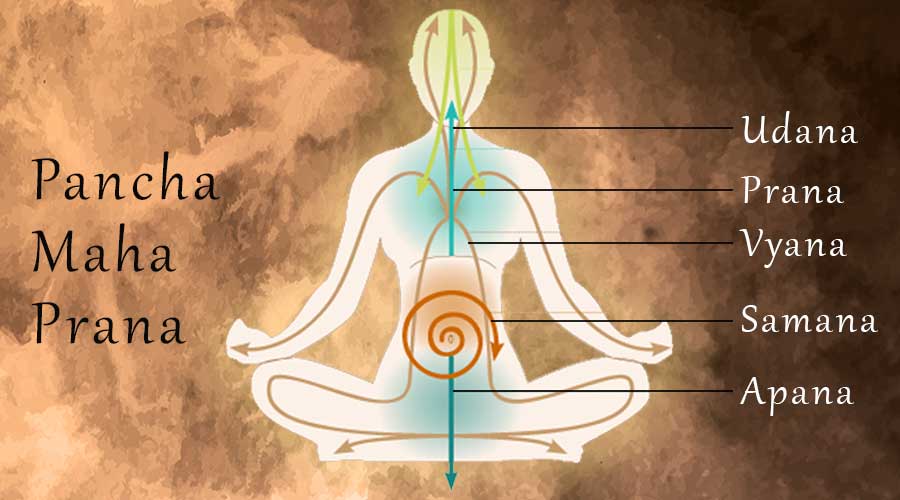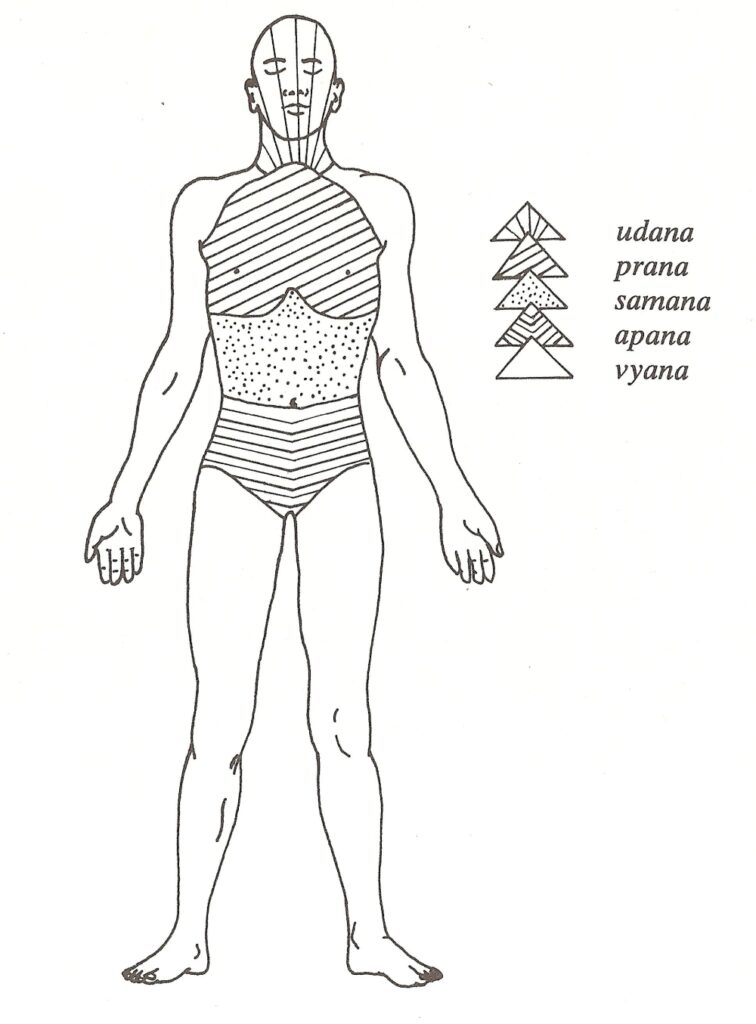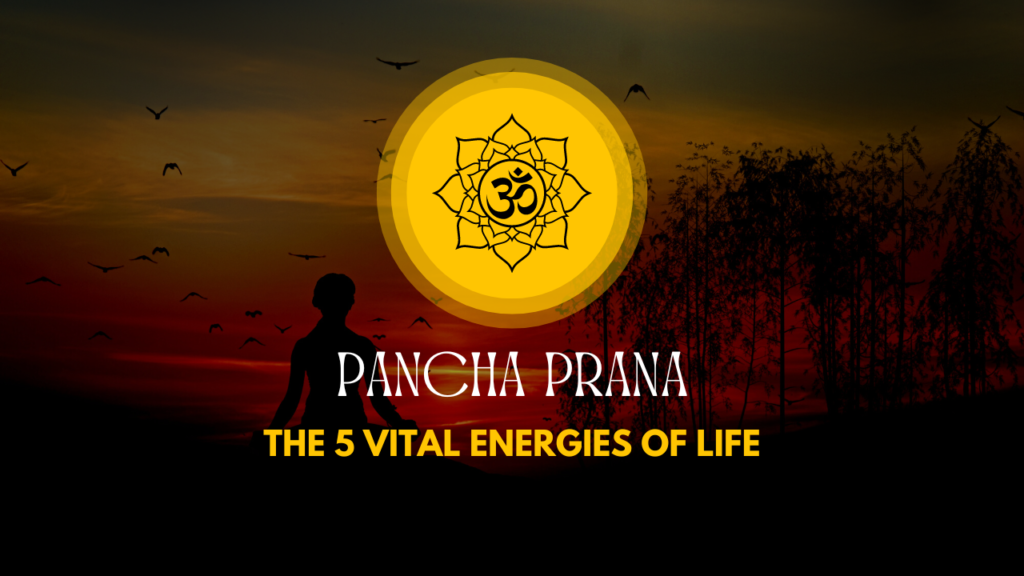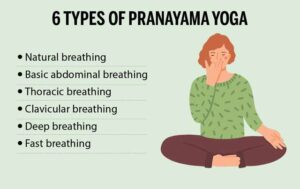Yoga is a holistic discipline of health & well being. It was crafted for the purpose keeping the vehicle of body fit and healthy so that the individual is capable of continuing the pursuit of SELF without any delays or obstructions. The concepts taught in Yoga philosophy range from the grosser to subtler aspects of human body and its energy counterpart. As per the tradition, there is a subtle layer of energy that exist beyond the material dimension. This energy body is called Pranamaya kosha (Pran= energy Maya=made of ; kosha= sheath). This layer comprise of the vital energy being circulated in a systematic circuit of Nadis. A nadi is a channel of energy which creates a circuit of Pranic distribution in the body. These channels supply all the major organs with vital energy to sustain their functioning. In yoga therapy, this concept is primary to repair and maintenance of sick and diseased tissues.
This Prana, although being a unified stream of energy, is categorized on the basis of regions and functions is serves in the human body. According to Yoga Chudamani Upanishad, these five categories are mentioned in the below sutra:
Hridi Praanah Sthito Nityamapaano Gudamandale.
Samaano Naabhideshe tu Udaanah Kanthamadhyagah;
Vyaanah Sarva Shareere tu Pradhaanaah Pancha Vaayavah.
“Prana is located in the heart and Apana is always in the lower regions. Samana is located in the navel region and Udana in the throat region. Vyana moves in the entire body. These are five principle vital airs.”

Vayu is the word that is used to denote each of these categories. Vayu literally means that which moves for flows. Hence the word is used. We study and understand these 5 primary Vayus in terms of their place of existence in human body, their direction of their movement & the physiological functions they govern. So let’s have a look on their essential characteristics:
- PRANA VAYU referred to here is sthoola prana or the physical manifestation of energy. This prana belongs to a specific part of the body located in the region between the larynx and diaphragm. It is associated with the respiratory tract, heart and the Oesophagus, together with the muscles and nerves that activate them. Prana is primarily upward moving force which also moves downwards. It is the force by which the breath is drawn in and then expelled and food and liquids are swallowed. Also it is responsible for pranic absorption and directing all the other vayus in the body. Prana vayu is regulated by the practice of Jalandhar bandha. (the throat lock)
- APANA VAYU flows in the lower regions between the navel & perineum. It is a downward moving force which governs the processes of elimination; not only of urine, faeces, gas, wind, semen, menstrual flow and childbirth, but also of negative, mental and emotional experience. It provides energy for the functioning of the large intestine, kidneys, bladder, anus, genitals and womb. Apana vayu is regulated by the practice of moolabandha (root lock).
- SAMANA VAYU moves in a lateral pattern. It is prevalent in the region between the diaphragm and the navel, the middle part of the abdomen. It governs the processes of digestion, both of food, water and air, small intestines, liver, pancreas and the secretions of these organs. It is responsible for assimilation of nutrients as well and heating and cooling in the body. It also activates the heart and circulatory system. Samana is also a vayu governing emotional and mental experience, discernment, inner absorption and self-consolidation. This is where both the Prana & Apana vayus are supposed to diffuse with the practice of Uddiyan bandha (abdominal lock).
- UDANA VAYU is a spiraling force which maintains the peripheral parts of the body including the head above the larynx. . It governs the brain and all sensory receptors; eyes, ears, nose, tongue and skin, as well as three organs of action; speech, hands and feet. Without it there would be no perception, thinking or action in us. It is regulated by the practice of Jalandhara Bandha (the throat lock).
- VYANA VAYU is the all-pervasive force which moves in every direction throughout the body. It acts as a reserve force for the other pranas. It any prana becomes depleted, vyana steps in and maintains the balance. It is prevalent in the entire body especially in the lower & upper extremities. It governs physical movement and coordinates the other vital energies. Vyana harmonizes and activates the limbs, associated muscles, ligaments, nerves and joints. It is also responsible for the erect posture of the body. It also governs the process of circulation on all levels, including oxygen, food, water, nerve impulses, thoughts, expansiveness and pervasiveness.

Apart from the above there are 5 sub categories of Prana vayu which are as follows:
- Naag: responsible for bringing up the contents of stomach as in belching, eructation and vomiting.
- Kurma: maintains the blinking of eyes and keep them moist.
- Krikara: responsible for sneezing
- Devdatta: responsible for yawning.
- Dhananjaya: maintains physical warmth and remain the in the body even after death causing rigor mortis.
These five energies flow through the nadis of all living beings and help to maintain the internal harmony of the body.
In the process of living, these vayus can be depleted. Reasons for depletion can be multiple. Our lifestyle choices of food, recreation, sensory indulgence, addictions, habits that we develop overtime, they all play a role is depletion of vital energies. There can be various symptoms that a person can experience as a result of this depletion. It may include:
- Breathlessness, asthma, bronchitis, hiccoughs
- Cold, congestion, cough
- Hoarse voice
- Low immunity and energy
- Poor circulation,
- Heart palpitations
- Indigestion
- Constipation
- IBS
- Depression
- Blood pressure issues
- Sleep apnea
- Poor posture
- Excessive anxiety, worry, fear, anger
- headaches
- Loss of focus
- Emotional blockages due to imbalances in the heart chakra
- Poor reflexes
- Loss in proprioception
Yoga offers a holistic approach towards restoring the Pranic reservoirs through a multitude of practices given to us. A yogic lifestyle includes all the necessary elements to bring back the amplitude of Prana. With the practice of Asanas we can work remove the sluggishness in Nadis and restore smooth energy transfer. Pranayam helps in expanding the quantity of prana in the system. Meditations of various kinds brings steadiness and calmness in the volatile frequencies thus ensuring a calm and healthy experience of life.
The main purpose of Yogic pranayama is to establish a harmony between these vayus so that new dimension of well being and awareness can be experienced. Pranayama is not just the practice of breathing exercises rather it is a carefully crafted modality of gaining control over this vital energy and allowing it to reach to farther spaces within the human system. Please note that all the pranayama practices must be learned from a teacher or Guru to gain maximum benefits.
Regards
Hariomtatsat






